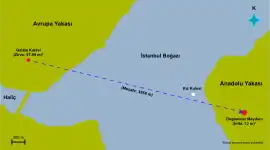Hezârfen Ahmed Çelebi
Hezârfen Ahmed Çelebi (Ottoman Turkish: هزارفنّ أحمد چلبی,, lit. 'Polymath Ahmed the wise';[1][2] 1609 – 1640) was an Ottoman scientist, inventor, chemist, astronomer, physician, Andalusi musician, and poet from Constantinople, reported in the writings of traveler Evliya Çelebi to have achieved sustained unpowered flight.[3][4]
Hezârfen Ahmed Çelebi | |
|---|---|
| Born | Ahmed 1609 |
| Died | 1640 (aged 30–31) |
| Nationality | Ottoman |
| Occupation | Scientist |
| Known for | first sustained unpowered flight |
| Relatives | Lagâri Hasan Çelebi (brother) |
Etymology of name
The title "Hezârfen", given by Evliyâ Çelebi to Ahmed Çelebi, is from Persian هزار hezār meaning -a thousand- + فنّ fann meaning -science together making it together Ahmed having talents in "a thousand of sciences (polymath).[1]
Non-powered flight

The 17th century writings of Evliyâ Çelebi relate this story of Hezârfen Ahmed Çelebi, circa 1630–1632:
First, he practiced by flying over the pulpit of Okmeydanı eight or nine times with eagle wings, using the force of the wind. Then, as Sultan Murad Khan (Murad IV) was watching from the Sinan Pasha mansion at Sarayburnu, he flew from the very top of the Galata Tower (in contemporary Karaköy) and landed in the Doğancılar Square in Üsküdar, with the help of the south-west wind. Murad Khan then rewarded him for his feat with a sack of gold coins, saying: "This man is uncanny: he is capable of doing anything he wishes. It is not right to surround oneself with such people". True to his word, he then exiled Ahmed to Algeria, where the scientist remained until his death.
— Evliyâ Çelebi, [3]
While modern historians disagree with Evliya Çelebi's narration of Hezarfen flying the entire Bosporus,[5] they state that the flight most likely was real, but heavily exaggerated, as Çelebi often exaggerates in his writings.[6][7]
Legacy
- One of 4 airports in Istanbul is named the "Hezarfen Airfield".
- A 1996 feature-length film, "Istanbul Beneath My Wings" (İstanbul Kanatlarımın Altında) concerns the lives of Hezârfen Ahmet Çelebi, his brother and rocket aviator Lagari Hasan Çelebi, and Ottoman society in the early 17th century, as witnessed and narrated by Evliyâ Çelebi.
- The Turkish children’s TV show “Little Hezarfen” (Küçük Hezarfen) is about Hezârfen Ahmet Çelebi’s childhood, though the events that occur within the show are likely fictitious and/or exaggerated. A main theme within the show, however, is Hezarfen’s desire to build wings that allow him to fly.[8]
See also
References
- hezarfen Archived 20 October 2013 at the Wayback Machine TDK Büyük Türkçe Sözlük. Erişim: 26 Mayıs 2009
- "çelebi". Nişanyan Sözlük (in Turkish). Archived from the original on 9 November 2019. Retrieved 9 November 2019.
- Çelebi, Evliya (2003). Seyahatname. Istanbul: Yapı Kredi Kültür Sanat Yayıncılık, p. 318.
- Rafiq, Tehmina. "Role of Muslim Scientists in the Development of the Sciences." Al-Irfan 7, no. 13 (2022): 1-16.
- Yalçın, Tuncer (2018-10-26). "Hezarfen Ahmet Çelebi Kimdir? Gerçekten Uçtu Mu?". Ders: Tarih (in Turkish). Retrieved 2020-11-26.
- Özay, Yeliz. "EVLİYÂ ÇELEBİ SEYAHATNÂMESİ'NİN ACÂİB EDEBİYATI AÇISINDAN DEĞERLENDİRİLMESİ" (in Turkish).
- HIZLAN, Doğan. "Postmodern bir romancı: Evliya Çelebi". www.hurriyet.com.tr (in Turkish). Retrieved 2020-11-26.
- "Küçük Hezarfen İzle TRT Çocuk". TRT Çocuk.